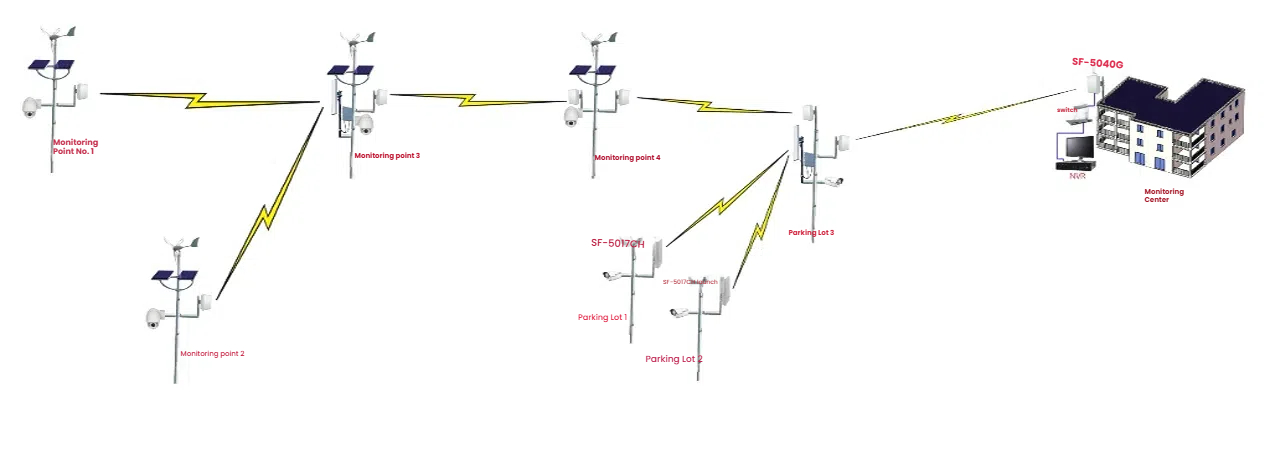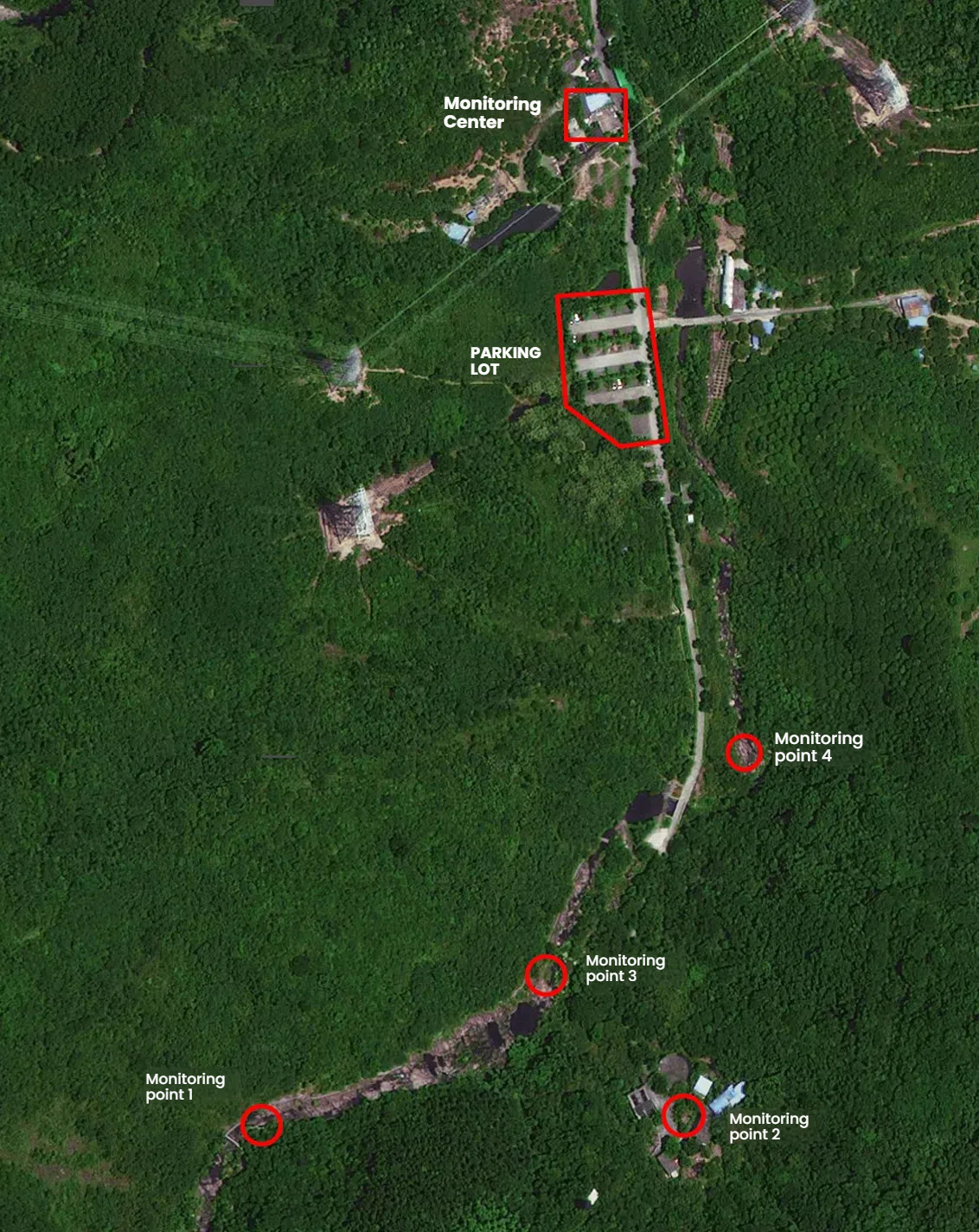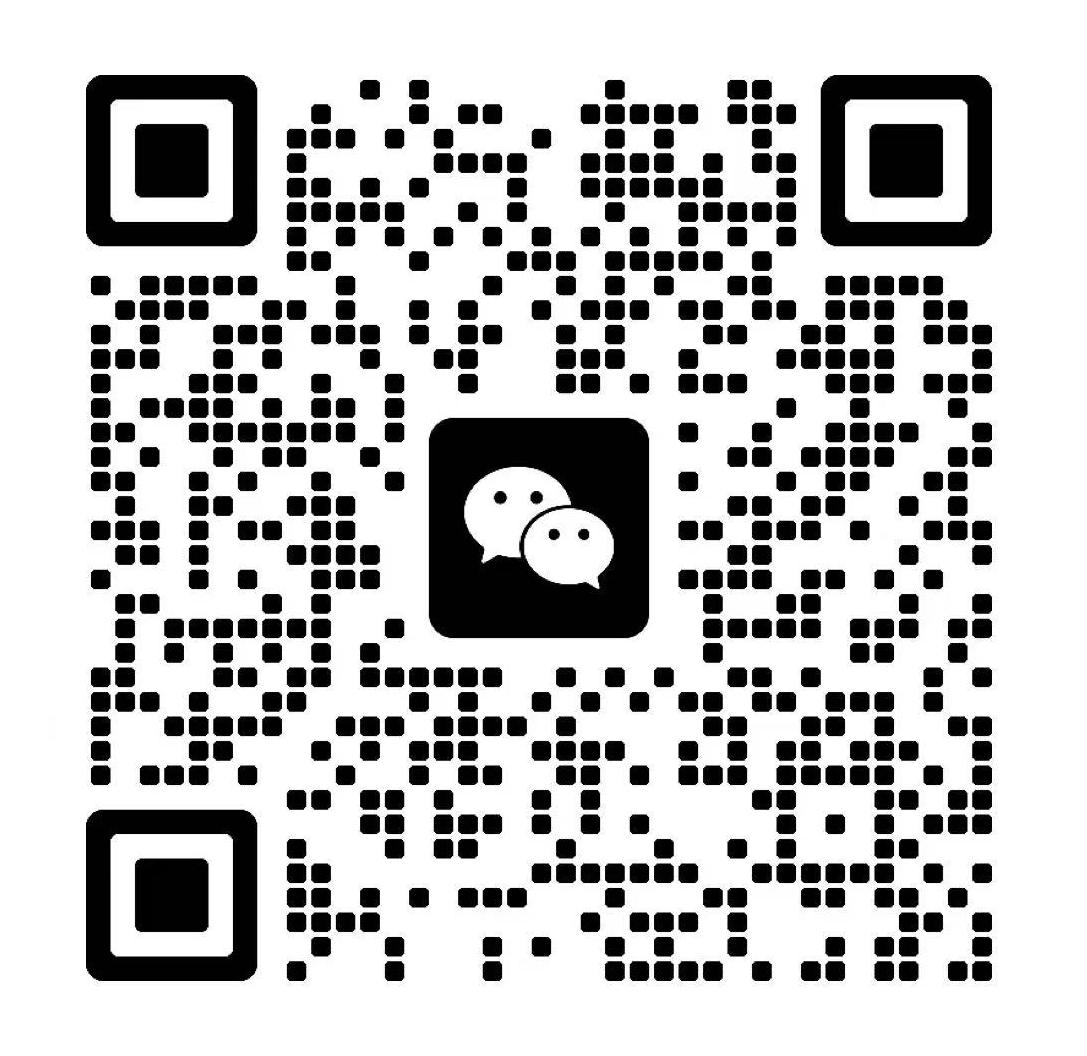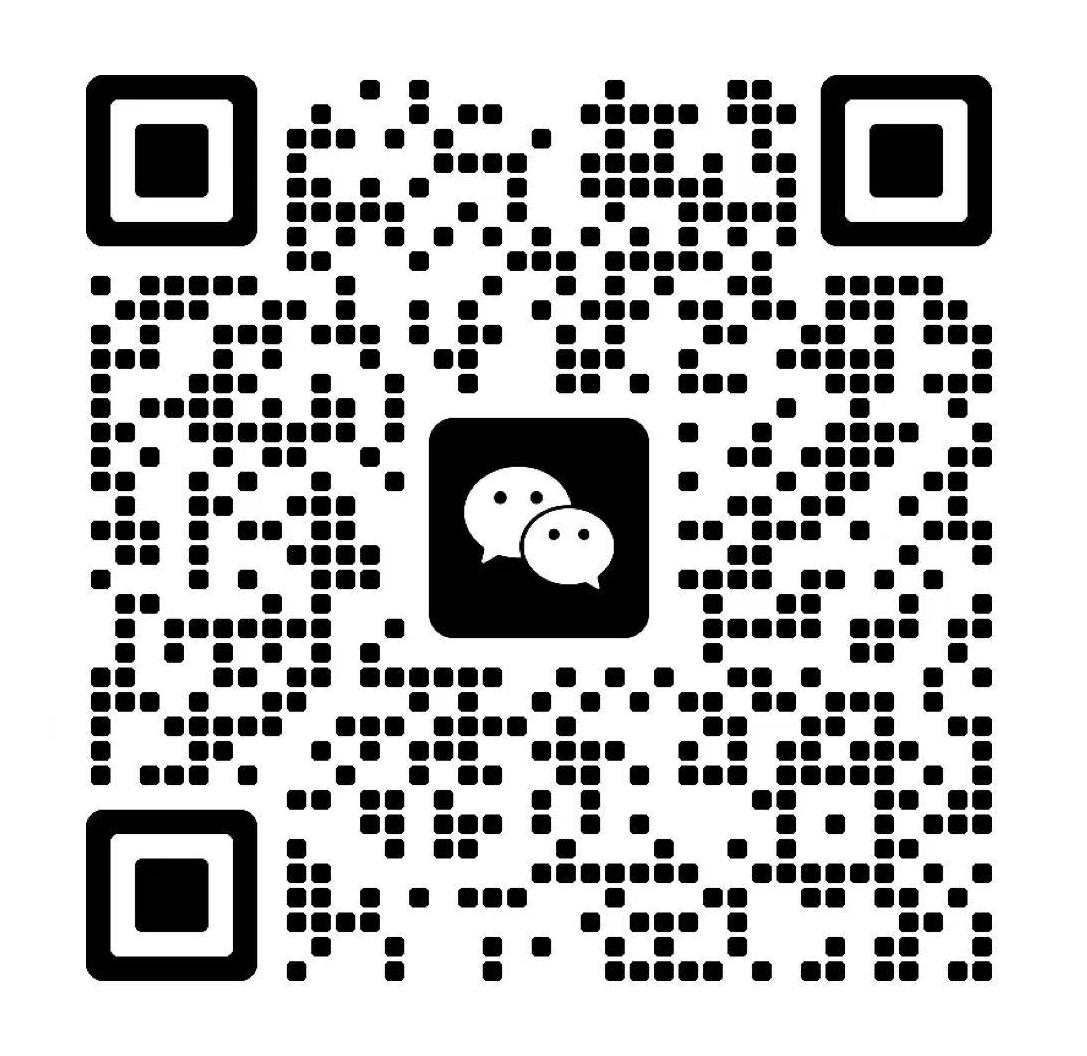Wireless Transmission Scheme for a Rural Park
With the continuous development of nature reserves and the increasing number of tourists, higher requirements have been put forward for communication, monitoring, and emergency response within the parks. Nature reserves usually have complex terrain, covering various landforms such as mountains, forests, grasslands, and water bodies. Traditional wired network cabling is not only costly and difficult to install, but also prone to failure in the event of natural disasters or human damage, making it unable to meet the real-time communication and comprehensive monitoring needs of the parks. Wireless ad hoc network equipment, with its features of not relying on fixed infrastructure and the ability to quickly and flexibly form networks, provides an ideal solution for the wireless transmission problems in nature reserves.

▲Scene equipment installation effect drawing
The working principle of wireless ad hoc network devices is to enable each node in the network to have the functions of routing and forwarding. Nodes communicate with each other through wireless signals. When a node needs to send data, if it cannot directly communicate with the target node, it will send the data to the adjacent node. The adjacent node then forwards the data step by step according to the network topology and routing algorithm until it reaches the target node. This method can break through terrain limitations and build a stable communication network in complex rural environments. For example, in the mountainous areas of a park, the base station signal is difficult to cover. At this time, the ad hoc network nodes deployed on patrol vehicles and monitoring points can cooperate with each other to relay the collected information to the management center.
The technical advantages of wireless ad hoc network devices are extremely significant. Their flexible networking capability does not rely on fixed communication base stations. In areas lacking infrastructure such as rural parks, as long as the devices are turned on, they can automatically search for and connect to surrounding nodes, quickly establishing a communication network to meet the communication needs of different areas within the park. The strong self-healing ability is also crucial. When a certain node fails due to equipment failure or terrain obstruction, the network will automatically sense and adjust the routing, bypassing the faulty node to re-establish the communication link, ensuring uninterrupted transmission. For example, if the ad hoc network device at a certain monitoring point is damaged by heavy rain, other nodes will quickly adjust the transmission path to ensure the normal transmission of data. The multi-hop relay technology can significantly expand the coverage area. Through the relay of multiple nodes, the signal can reach every corner of the park, including remote mountains, forests, and lakeside areas. At the same time, it can also provide high-bandwidth data transmission to meet the data transmission requirements of large amounts of data such as high-definition video surveillance and real-time transmission of environmental sensor data, enabling the management center to obtain clear monitoring images and accurate environmental information in a timely manner.
The rural parks have various requirements in terms of wireless transmission. Real-time monitoring is one of the important needs, which requires monitoring of tourists' activities, the dynamics of flora and fauna, and the condition of facilities throughout the day. In areas with dense tourist traffic, it is necessary to promptly grasp the flow of people to prevent accidents such as congestion and stampedes; in ecological protection areas, it is necessary to monitor the survival status of flora and fauna and promptly detect illegal hunting, logging, etc. At night, infrared monitoring equipment can be used to monitor abnormal activities within the park. Communication reliability is also indispensable. Park managers, patrol personnel, and the management center need stable communication to promptly convey instructions and report situations. For example, when patrol personnel discover a fire, they can quickly transmit the location, fire situation, etc. to the management center to ensure that rescue forces arrive in time. Data transmission security is also important. During the transmission process, the monitoring videos and tourist information of the park should be protected from being stolen or tampered with to avoid information leakage and negative impacts. In addition, considering that the patrol and emergency rescue work of the park is mobile, the wireless transmission equipment must have good mobility and portability. The handheld terminals carried by patrol personnel and the equipment on emergency vehicles can be connected to the network at any time to ensure smooth communication.
Based on these requirements, the system architecture of the wireless transmission scheme for the rural park consists of multiple components. The management center serves as the core hub, equipped with high-performance servers, data storage devices, and management software. It is responsible for processing, storing, and analyzing the data of the entire system. Managers can remotely control the equipment, view monitoring screens, and obtain real-time information about the park through the operation interface. They can also view the overall situation of the park through large screens. The patrol equipment are mobile nodes. The patrol vehicles and handheld terminals carried by the patrol personnel are equipped with ad hoc network devices. The patrol vehicles also have high-definition cameras and positioning devices, which can transmit real-time video images and location information along the way. The handheld terminals facilitate communication between the patrol personnel and the management center and other patrol personnel. The fixed monitoring points are distributed throughout the park, such as entrances, viewing platforms, and ecological protection areas. They are equipped with ad hoc network devices, high-definition cameras, environmental sensors, etc. The cameras are used to monitor the surrounding area, and the environmental sensors collect data such as temperature, humidity, air quality, and water quality, and transmit it to the management center through the ad hoc network. Emergency nodes play a role in emergency situations, such as portable ad hoc network devices deployed during emergency rescue, which can quickly set up a temporary communication network to ensure communication among rescue personnel and with the management center.
In terms of equipment selection and deployment, wireless ad hoc network devices should be chosen for use in rural environments, with features such as waterproofing, dustproofing, and anti-interference capabilities, and the ability to adapt to various climatic conditions including high and low temperatures and humidity. For example, a certain brand of ad hoc network equipment has flexible working frequency bands, can avoid interference with other wireless devices in the park, has a long transmission distance, and is suitable for use in open and complex terrains. During deployment, the equipment at fixed monitoring points can be installed at high positions, such as on utility poles or watchtowers, to enhance signal coverage; the equipment for patrol vehicles and handheld terminals should be made smaller and lighter to avoid affecting normal operation. In terms of surveillance cameras, the equipment at fixed monitoring points should select high-definition cameras with night vision and waterproof functions, which can clearly capture images in various weather conditions; the equipment for patrol vehicles should be installed with rotatable pan-tilt cameras to facilitate flexible monitoring of the surrounding area. Environmental sensors need to be selected based on monitoring requirements, such as temperature and humidity sensors, smoke sensors, water quality sensors, etc., and deployed in the corresponding areas to collect environmental data in real time. In terms of communication equipment, for managers and patrol personnel, walkie-talkies should be provided as backup communication means to ensure basic communication when the ad hoc network is abnormal, and the walkie-talkies should be selected with wide signal coverage and clear sound quality.
Data transmission and processing are mainly carried out through wireless ad hoc networks, with satellite communication or other public network communication as supplementary. Within the coverage area of the ad hoc network, data is transmitted preferentially using the ad hoc network, taking advantage of its high bandwidth and low latency to transmit high-definition videos, large amounts of environmental data, etc. In the extremely remote areas where the ad hoc network does not reach, key data can be transmitted through satellite communication and other means. During the data transmission process, encryption technology is adopted, such as the AES encryption algorithm, to ensure data security. The servers of the management center process and analyze the received data, using video analysis technology to identify abnormal situations, such as tourists entering prohibited areas, facility damage, etc.; analyzing environmental data to determine whether there are risks such as fires or environmental pollution, and storing the processed data for database establishment, providing data support for park management and planning. At the same time, through data visualization technology, the data is displayed in the form of charts and maps, facilitating managers to understand the situation intuitively.
The software system is highly functional, with real-time monitoring capabilities allowing managers to view the video images transmitted from each monitoring point and patrol equipment. It supports multi-screen simultaneous display and enables operations such as video playback and zooming. This facilitates a detailed understanding of the park's situation. The target tracking function can track suspicious individuals, vehicles, etc., based on the captured images and positioning information from the cameras. When the target enters a prohibited area or exhibits abnormal behavior, the system automatically issues an alarm. The data analysis function can analyze the park's flow data, environmental data, and equipment operation data, generating various reports to provide a basis for management decisions. For example, adjusting patrol routes based on the flow distribution and formulating ecological protection measures based on environmental data. The command and dispatch function enables the management center to issue instructions to patrol personnel and emergency teams, allowing for real-time tracking of their locations and statuses, achieving efficient scheduling. In emergencies, resources can be quickly allocated for handling. The user management function sets different permissions for different users to ensure the security of system operations. For example, managers have the highest permissions and can perform system settings and data management, while patrol personnel can only view the surveillance of relevant areas and receive instructions.

▲Wireless Monitoring Transmission Topology Map of a Certain Park
The implementation of the plan is divided into several steps. In the early stage of research and planning, a detailed investigation should be conducted on the topography and landform, area size, and existing facilities of the rural park, to understand the communication needs and environmental characteristics of different areas. For example, ecological protection areas require more stable monitoring transmission, while tourist-dense areas have higher bandwidth requirements. Communicate with the park management department to clarify their management procedures, monitoring priorities, and emergency response mechanisms. Based on the requirements, formulate a detailed equipment deployment plan, determine the location of monitoring points, the number and type of equipment, and conduct cost budgeting and benefit analysis to ensure the economic feasibility of the plan. In the equipment procurement and installation stage, purchase appropriate ad hoc network equipment, cameras, sensors, etc., select suppliers with reliable quality and good after-sales service, and strictly check the equipment parameters and quality. During installation, follow the deployment plan, ensure that the equipment at the monitoring points is firmly installed, and take measures such as waterproofing and lightning protection; patrol equipment and emergency equipment should be easy to carry and operate, and after installation, conduct debugging to ensure the normal operation of the equipment, and provide training for managers and staff to enable them to master the equipment operation and system usage methods. In the system debugging and optimization stage, comprehensively test the various functions of the system, check whether the communication between devices is stable, whether the data transmission is accurate, and whether the software functions are normal, simulate various scenarios such as equipment failure and adverse weather conditions, and test the system's response capabilities. Based on the test results, optimize the system, adjust equipment positions, routing algorithms, etc., to improve system performance and ensure that the system can adapt to the complex environment of the rural park. After the system is put into use, establish a complete maintenance mechanism, regularly check the equipment operation status, promptly repair and replace faulty equipment, and ensure the continuous and stable operation of the system. At the same time, in response to changes in park management needs and technological development, upgrade and expand the system, such as adding new monitoring points, introducing more advanced video analysis technologies, etc., to continuously improve the management level and service quality of the rural park.

▲The on-site illustration is as follows.








